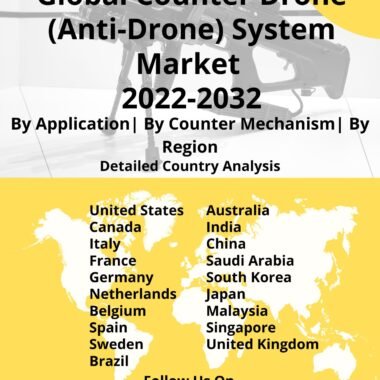Description
Satellite Navigation Market
Frequently Asked Questions of Global Satellite Navigation Market
Satellite navigation, also known as global navigation satellite systems (GNSS), refers to the use of satellite-based signals to determine accurate positioning, navigation, and timing information. The most well-known and widely used satellite navigation system is the Global Positioning System (GPS), operated by the United States government. GPS is a constellation of satellites orbiting the Earth, providing signals that can be received by GPS receivers on the ground or in other devices. By calculating the time it takes for signals to travel from multiple satellites to a receiver, GPS receivers can determine their precise location, typically in latitude, longitude, and altitude.
Satellite navigation systems rely on signals transmitted by satellites in space. These signals contain timing and positioning information. GPS receivers and other GNSS receivers receive and process these signals to calculate the user’s position, velocity, and time. These receivers can be standalone devices, integrated into smartphones, vehicles, aircraft, ships, and other equipment.
Operated by the European Union, Galileo is a European GNSS system designed to offer independent and global satellite navigation services. It aims to provide highly accurate positioning and timing information. Operated by the Russian Federation, GLONASS is a GNSS system that provides global coverage. It works similarly to GPS and enables users to determine their location using GLONASS satellites. Operated by China, the BeiDou Navigation Satellite System (BDS) is a GNSS system that provides global coverage. It offers positioning, navigation, and timing services to users worldwide. Operated by the Indian Space Research Organization (ISRO), NavIC (Navigation with Indian Constellation) is the Indian regional satellite navigation system. It provides accurate positioning and timing services over the Indian region and surrounding areas.
GPS and other satellite navigation systems are commonly used for personal navigation in smartphones and handheld devices. They provide turn-by-turn directions, real-time traffic information, and location-based services, and location-based services. Satellite navigation plays a crucial role in transportation and logistics industries. It enables precise positioning, navigation, and tracking of vehicles, vessels, and aircraft. It helps optimize routes, monitor fleet movements, and improve safety and efficiency. Satellite navigation systems are extensively used in surveying and mapping applications. They enable accurate positioning and mapping of land, infrastructure, and natural resources. Surveyors and cartographers use GNSS receivers to capture precise geospatial data.
Major factors driving Satellite Navigation Market Growth
The market is primarily driven by the deployment and utilization of global navigation satellite systems such as GPS, Galileo, GLONASS, BeiDou, and NavIC. These systems provide satellite signals that enable accurate positioning, navigation, and timing services worldwide.
Satellite navigation is increasingly utilized in agriculture for precision farming practices. It enables precise positioning for variable-rate seeding, automated guidance systems, yield monitoring, and crop health mapping, helping farmers optimize resource usage and increase productivity.
Satellite navigation systems are critical for defense and military operations. They provide precise positioning, navigation, and timing services for military vehicles, weapons systems, and personnel. Military-grade receivers often have enhanced features for security and anti-jamming capabilities.
Trends influencing the Satellite-Navigation Market Size
Satellite navigation is extensively used in automotive applications, including in-vehicle navigation systems and GPS-enabled car infotainment systems. These systems provide turn-by-turn directions, traffic updates, and other location-based services to drivers.
Satellite navigation systems are increasingly integrated with other technologies to enhance their capabilities. This includes the integration of satellite navigation with sensors, machine learning, artificial intelligence (AI), and cloud computing for advanced positioning and navigation solutions.
Satellite-Navigation Market Forecast & Dynamics
The field of satellite navigation continues to evolve with advancements in technology and the development of new satellite systems. This includes the ongoing modernization and expansion of existing systems like GPS, Galileo, and GLONASS, as well as the deployment of new satellite constellations.
The market forecast includes a comprehensive market analysis and market size. The market analysis includes regional market size, drivers, restraints, and opportunities. The regional analysis also includes country-wise market size.
Satellite Navigation Market Analysis for Recent Developments
NavIC, a chip that can form the foundation of the Navigation, Positioning, and Timing applications developed by Elena Geo Systems, a Bengaluru-based space technology company, was introduced at the Defence Space Symposium on Thursday as a step towards widening the use of indigenous satellite-based navigation. The chip communicates with satellites from the Indian Constellation (NavIC) or the Indian Regional Navigation Satellite System (IRNSS). According to Elena Geo Systems’ founder, the processor will give India a significant advantage because both the government and private sector will be able to reduce their reliance on the American Global Positioning System.
The Pentagon is ready to launch a test vessel that will help the country’s satellite navigation capabilities. The spacecraft, known as Navigation Technology Satellite-3 (NTS-3), will be the first experimental navigation satellite launched by the United States since NTS-1 and NTS-2 in the 1970s. L3Harris Technologies’ NTS-3 recently completed testing at the Benefield Anechoic Facility (BAF) at Edwards Air Force Base in California. Technicians were able to test the satellite’s systems without interfering with or mistakenly jamming neighboring air, auto, and other GPS (global positioning system) signals thanks to the specialized facilities.





